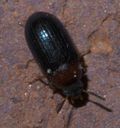Polygraphini
Polygraphini
Classification
- Phylum: Arthropoda
- Subphylum: Hexapoda
- Class: Insecta
- Order: Coleoptera
- Suborder: Polyphaga
- Superfamily: Curculionoidea
- Family: Curculionidae
- Subfamily: Scolytinae
- Tribe: Polygraphini
Pronunciation
How to pronounce Polygraphini: /ˌpɒl.iˈɡræf.ɪ.naɪ/
These audio files are automatically generated. While they are not always 100% accurate, they are a good starting point.
Images



Summary
The tribe Polygraphini consists of bark beetles primarily found north of Mexico, adapted to live on conifers, especially those from the Pinaceae family. They play a pivotal role in forest ecosystems through their feeding habits but also pose significant economic threats as pests.
Physical Characteristics
Bark beetles are small, cylindrical-shaped beetles with small appendages, including antennae that can be folded into the body and large mandibles for excavation of woody tissue. They have very short legs that can be retracted or folded into their body, and flattened eyes believed to assist in low-light visibility.
Identification Tips
Look for cylindrical shape, small size, and retracted legs; often found boring into the bark of conifer trees.
Habitat
Bark beetles inhabit the inner bark (phloem) of various tree species, particularly conifers in North America.
Distribution
Primarily distributed across North America, with 14 species in the tribe Polygraphini found north of Mexico and its relatives found across the continent.
Diet
Bark beetles mainly feed on the phloem layer of trees, although some species bore into wood, feed on fruit and seeds, or tunnel into herbaceous plants.
Life Cycle
Bark beetles go through four life stages: egg, larvae, pupae, and adult. Development time varies by species and temperature. Generally, adults bore into trees and lay eggs in the phloem, where larvae feed and create chambers for pupation before emerging as adults.
Reproduction
Bark beetles reproduce by laying eggs in the phloem of trees, usually during mid to late summer. Larvae develop in the tree and can impact its health significantly.
Predators
Bark beetles are preyed upon by woodpeckers, certain beetles, flies, and phoretic mites, some of which may also parasitize them.
Ecosystem Role
Bark beetles are crucial for the recycling and decomposition of dead and dying wood in forests, influencing forest regeneration and biodiversity.
Economic Impact
Bark beetles are significant pests, leading to extensive damage in forests and impacting the lumber industry, particularly due to outbreaks like those of the mountain pine beetle, which have killed millions of acres of forest.
Evolution
There are around 6,000 described species of bark beetles placed into 26 tribes, showing a diverse evolutionary history.
Similar Taxa
Misconceptions
Bark beetles are often confused with other beetles but are specifically adapted for boring into trees and feeding on phloem.
Tags
- Polygraphini
- Bark Beetles
- Scolytinae
- Conifer Pests